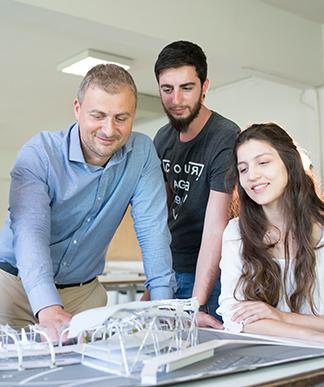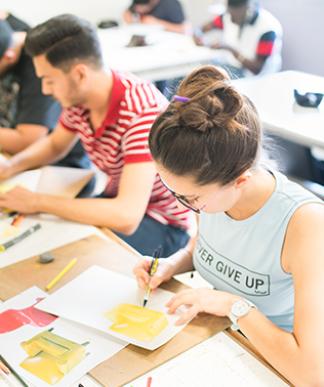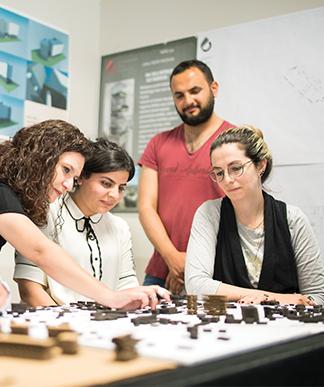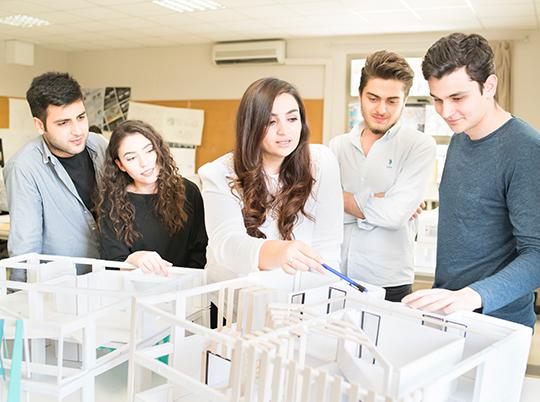


About the Program
The main goal of the program is to equip students with the creative, technical and analytical skills they need to build a successful career in the professional world of architecture and design.The mission of the program is to train professionals who are learning-oriented, based on value creation, questioning, and interpretation, subjective, creative, sensitive and responsible in social, cultural and environmental contexts, with design, implementation and management skills in a free atmosphere. The vision of the program is to make it a pioneer in thinking, learning and acting architecturally by using the contributions and potentials of different cultural belongings and experiences, as well as the possibilities of its geography, and to serve the local and international community, information and cultural environment with the awareness of its natural, historical and cultural values; being open to change, universal knowledge and developments.
Educational Opportunities
A gap in TRNC higher education will be filled and the range of education fields offered to students will be enriched with this program. Aim of the program is to train architects who have gained business practice in the field of architecture and to provide 5-year architectural education with integrated education after the 4-year education process. It will contribute to the training of architects who dominate the architectural offices and the construction sector, the number of which is increasing in the TRNC, and the management of these institutions based on the principles of more scientific, efficiency and effectiveness by training the architects. Graduates of the program, which is prepared in accordance with the bylaw amendment that KTMMOB Chamber of Architects has prepared, will be able to enroll in the professional chamber without requesting an additional training process. Also, in Nigeria where architectural education is accepted as 5 years, our graduates' diploma equivalence procedures will be solved without any problems.

Career Areas
Graduates of this program can work as freelance architects or paid architects in an architectural office or open their own architectural design office. They may also work in the industrial sector or in the technology-related design process to focus on the development and production of building materials or the urban environment. They also have the opportunity to work in research and education as an academic career. In addition to these, it has been observed that many architects have acquired successful professions in different fields such as literature, media, cinema, music, industry and entrepreneurship with their unique perspectives and creativity that they have developed with architectural education. In this way, responsible professionals in creative, social, cultural and environmental contexts have the ability to design, implement and direct architectural projects.
İletişim
Faculty of Fine Arts, Design and Architecture
Education and Humanities Center, EH323
Tel: +90 392 671 1111 Extension: 2101
Faculty E-mail: secretary-ffa@ciu.edu.tr
Head of Department: Asst. Prof. Dr. Sertaç İlter
Head of Department E-mail: silter@ciu.edu.tr
Compulsory Courses
First Semester
BASIC ARCHITECTURAL DESIGN-I
Course code
ARCH101Credit
5Theoretical
3Practical
4Ects
8ARCHITECTURAL DRAWING-I
Course code
ARCH105Credit
3Theoretical
2Practical
2Ects
4STATICS FOR ARCHITECTS
Course code
ARCH107Credit
3Theoretical
2Practical
2Ects
2READING AND WRITING SKILLS-I
Course code
ENGL141Credit
3Theoretical
2Practical
2Ects
4FREEHAND DRAWING
Course code
FADA103Credit
2Theoretical
1Practical
2Ects
4INTRODUCTION TO COMPUTERS
Course code
ITEC110Credit
3Theoretical
3Practical
0Ects
4BASIC MATHEMATICS
Course code
MATH107Credit
2Theoretical
2Practical
0Ects
4Second Semester
BASIC ARCHITECTURAL DESIGN-II
Course code
ARCH102Credit
5Theoretical
3Practical
4Ects
8ARCHITECTURAL DRAWING-II
Course code
ARCH106Credit
3Theoretical
2Practical
2Ects
4INTRODUCTION TO CONSTRUCTION
Course code
ARCH108Credit
3Theoretical
2Practical
2Ects
4DESCRIPTIVE GEOMETRY AND PERSPECTIVE
Course code
ARCH110Credit
3Theoretical
2Practical
2Ects
4READING AND WRITING SKILLS-II
Course code
ENGL142Credit
3Theoretical
2Practical
2Ects
4RENDERING AND PRESENTATION TECHNIQUES
Course code
FADA104Credit
2Theoretical
1Practical
2Ects
4TURKISH LANGUAGE
Course code
TREG100Credit
0Theoretical
2Practical
0Ects
2TURKISH
Course code
TURK100Credit
0Theoretical
2Practical
0Ects
2Third Semester
ARCHITECTURAL DESIGN-I
Course code
ARCH201Credit
5Theoretical
3Practical
4Ects
9BUILDING MATERIALS
Course code
ARCH203Credit
2Theoretical
1Practical
2Ects
3CONSTRUCTION AND CONSTRUCTION MANAGEMENT-I
Course code
ARCH207Credit
3Theoretical
2Practical
2Ects
4BUILDING PHYSICS-I
Course code
ARCH209Credit
2Theoretical
1Practical
2Ects
4HISTORY OF ANCIENT ARCHITECTURE
Course code
ARCH211Credit
2Theoretical
2Practical
0Ects
2COMPUTER AIDED DESIGN-I
Course code
FADA205Credit
2Theoretical
1Practical
2Ects
4FREE ELECTIVE
Course code
FREEXX1Credit
3Theoretical
3Practical
0Ects
4Fourth Semester
ARCHITECTURAL DESIGN-II
Course code
ARCH202Credit
5Theoretical
3Practical
4Ects
9INTRODUCTION TO URBAN PLANNING AND DESIGN
Course code
ARCH204Credit
2Theoretical
1Practical
2Ects
3CONSTRUCTION AND CONSTRUCTION MANAGEMENT-II
Course code
ARCH208Credit
3Theoretical
2Practical
2Ects
4BUILDING PHYSICS-II
Course code
ARCH210Credit
2Theoretical
1Practical
2Ects
4HISTORY OF CONTEMPORARY ARCHITECTURE
Course code
ARCH212Credit
2Theoretical
2Practical
0Ects
2COMPUTER AIDED DESIGN-II
Course code
FADA206Credit
2Theoretical
1Practical
2Ects
4FREE ELECTIVE
Course code
FREEXX2Credit
3Theoretical
3Practical
0Ects
4Fifth Semester
SUMMER TRAINING-I
Course code
ARCH200Credit
0Theoretical
0Practical
0Ects
3ARCHITECTURAL DESIGN-III
Course code
ARCH301Credit
5Theoretical
3Practical
4Ects
9BEHAVIOR AND ANALYSIS OF STRUCTURES-I
Course code
ARCH303Credit
3Theoretical
2Practical
2Ects
3RESTORATION AND PRESERVATION-I
Course code
ARCH305Credit
2Theoretical
2Practical
0Ects
2AREA ELECTIVE
Course code
ARCHXX1Credit
2Theoretical
2Practical
0Ects
5AREA ELECTIVE
Course code
ARCHXX2Credit
2Theoretical
2Practical
0Ects
5FREE ELECTIVE
Course code
FREEXX3Credit
3Theoretical
3Practical
0Ects
4Sixth Semester
ARCHITECTURAL DESIGN-IV
Course code
ARCH302Credit
5Theoretical
3Practical
4Ects
9BEHAVIOR AND ANALYSIS OF STRUCTURES-II
Course code
ARCH304Credit
3Theoretical
2Practical
2Ects
3RESTORATION AND PRESERVATION-II
Course code
ARCH306Credit
2Theoretical
1Practical
2Ects
3AREA ELECTIVE
Course code
ARCHXX3Credit
2Theoretical
2Practical
0Ects
5AREA ELECTIVE
Course code
ARCHXX4Credit
2Theoretical
2Practical
0Ects
5FREE ELECTIVE
Course code
FREEXX4Credit
3Theoretical
3Practical
0Ects
4Seventh Semester
SUMMER TRAINING-II
Course code
ARCH300Credit
0Theoretical
0Practical
0Ects
3ARCHITECTURAL DESIGN-V
Course code
ARCH401Credit
5Theoretical
3Practical
4Ects
9INTEGRATED APPLICATION PROJECT
Course code
ARCH403Credit
3Theoretical
1Practical
4Ects
3ARCHITECTURAL GRADUATION PROJECT RESEARCH
Course code
ARCH405Credit
2Theoretical
2Practical
0Ects
2COST ESTIMATION AND SITE MANAGEMENT
Course code
ARCH407Credit
2Theoretical
2Practical
0Ects
3AREA ELECTIVE
Course code
ARCHXX5Credit
2Theoretical
2Practical
0Ects
5UNIVERSITY ELECTIVE
Course code
UNIEXX1Credit
3Theoretical
3Practical
0Ects
5Eighth Semester
ARCHITECTURAL GRADUATION PROJECT
Course code
ARCH402Credit
5Theoretical
3Practical
4Ects
11ARCHITECTURAL DESIGN ETHICS
Course code
ARCH404Credit
2Theoretical
2Practical
0Ects
2AREA ELECTIVE
Course code
ARCHXX6Credit
2Theoretical
2Practical
0Ects
5HISTORY OF CIVILIZATION
Course code
HIST100Credit
0Theoretical
2Practical
0Ects
2MODERN TURKISH HISTORY
Course code
TARH100Credit
0Theoretical
2Practical
0Ects
2UNIVERSITY ELECTIVE
Course code
UNIEXX2Credit
3Theoretical
3Practical
0Ects
5UNIVERSITY ELECTIVE
Course code
UNIEXX3Credit
3Theoretical
3Practical
0Ects
5Ninth Semester
ARCHITECTURAL DESIGN VII
Course code
ARCH501Credit
5Theoretical
3Practical
4Ects
15INTRODUCTION TO FINAL PROJECT
Course code
ARCH550Credit
3Theoretical
3Practical
0Ects
5AREA ELECTIVE
Course code
ARCHXX7Credit
2Theoretical
2Practical
0Ects
5FREE ELECTIVE
Course code
FREEXX5Credit
2Theoretical
2Practical
0Ects
5Tenth Semester
FINAL PROJECT
Course code
ARCH560Credit
5Theoretical
3Practical
4Ects
25UNIVERSITY ELECTIVE
Course code
UNIEXX4Credit
3Theoretical
3Practical
0Ects
5Elective Courses
INTRODUCTION TO INTERIORS
Course code
ARCH309Credit
3Theoretical
2Practical
2Ects
6INTRODUCTION TO LANDSCAPE ARCHITECTURE
Course code
ARCH307Credit
3Theoretical
2Practical
2Ects
5SOCIAL & IDEO. ISSUES OF SPACE
Course code
ARCH414Credit
2Theoretical
2Practical
0Ects
3TRNC Applicants
TRNC citizens and TR citizen candidate students who have completed their entire high school education in TRNC. They are placed in undergraduate programs in line with their success in the CIU Student Placement and Scholarship Ranking Exam and the programs they prefer.
Students who are successful in the exam can register from the TRNC Marketing Office.
Applicants can directly apply online to our undergraduate programs using the application portal. Please fill in your details correctly and upload all the required documents listed on the last page of the application form.
Required documents;
- Completed application form,
- Higher/Secondary Certificate or equivalents (e.g. O/A’Level, WAEC/NECO),
- Evidence of English Language competence: TOEFL (65 IBT) or IELTS (5.5). Students without these documents will take the CIU English proficiency exam on campus following arrival,
- Scanned copy of international passport/birth certificate,
- Fully completed and signed CIU Rules and Regulations document (which can be downloaded during the online application).
Cyprus International University provides academic scholarships for its students as an incentive for success, with most students benefiting from 50%, 75% or 100% scholarships or discounted tuition fees. Click for more information.
Tuition Fees are determined at the beginning of each academic year. Candidate students who are entitled to enroll in CIU can learn their fees in line with the Tuition Fee Calculation system.